CURRENT RESEARCH TOPICS
Wall Modelled Large Eddy Simulation
Collaborators: Francesco De Vanna, Michele Cogo and Prof. Francesco Picano, Prof. Matteo Bernardini (Sapienza) and Prof. Ernesto Benini.
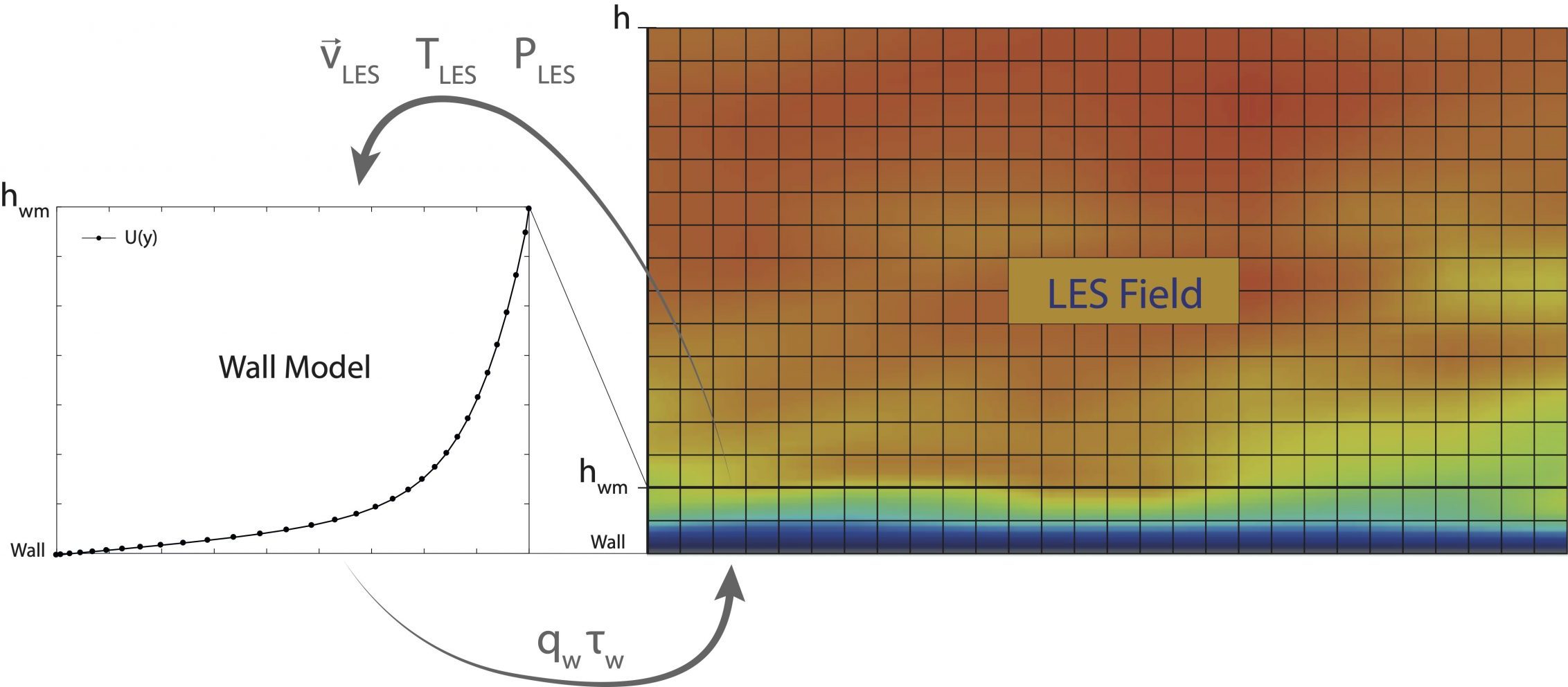 Large-eddy-simulation is a promising strategy for turbulent flow simulation in applications. However, a very fine mesh is required near the wall (wall-resolved) for reliable results, so wall-modelled methods have been developed to reduce the computational cost. We are developing efficient algorithms to provide the best wall treatment for different flow conditions (e.g. attached vs separated flows). Our methodology has been tested in incompressible and compressible turbulent channels and boundary layers with good results.
Large-eddy-simulation is a promising strategy for turbulent flow simulation in applications. However, a very fine mesh is required near the wall (wall-resolved) for reliable results, so wall-modelled methods have been developed to reduce the computational cost. We are developing efficient algorithms to provide the best wall treatment for different flow conditions (e.g. attached vs separated flows). Our methodology has been tested in incompressible and compressible turbulent channels and boundary layers with good results.
Reference(s):
- F De Vanna, M Cogo, M Bernardini, F Picano, E Benini, Unified wall-resolved and wall-modeled method for large-eddy simulations of compressible wall-bounded flows, Physical Review Fluids 6 (3), 034614, 2021
Reentry capsule on Mars atmosphere
Collaborators: Luca Placco, Giulio Soldati (Sapienza), Prof. Francesco Picano and Prof. Matteo Bernardini (Sapienza).
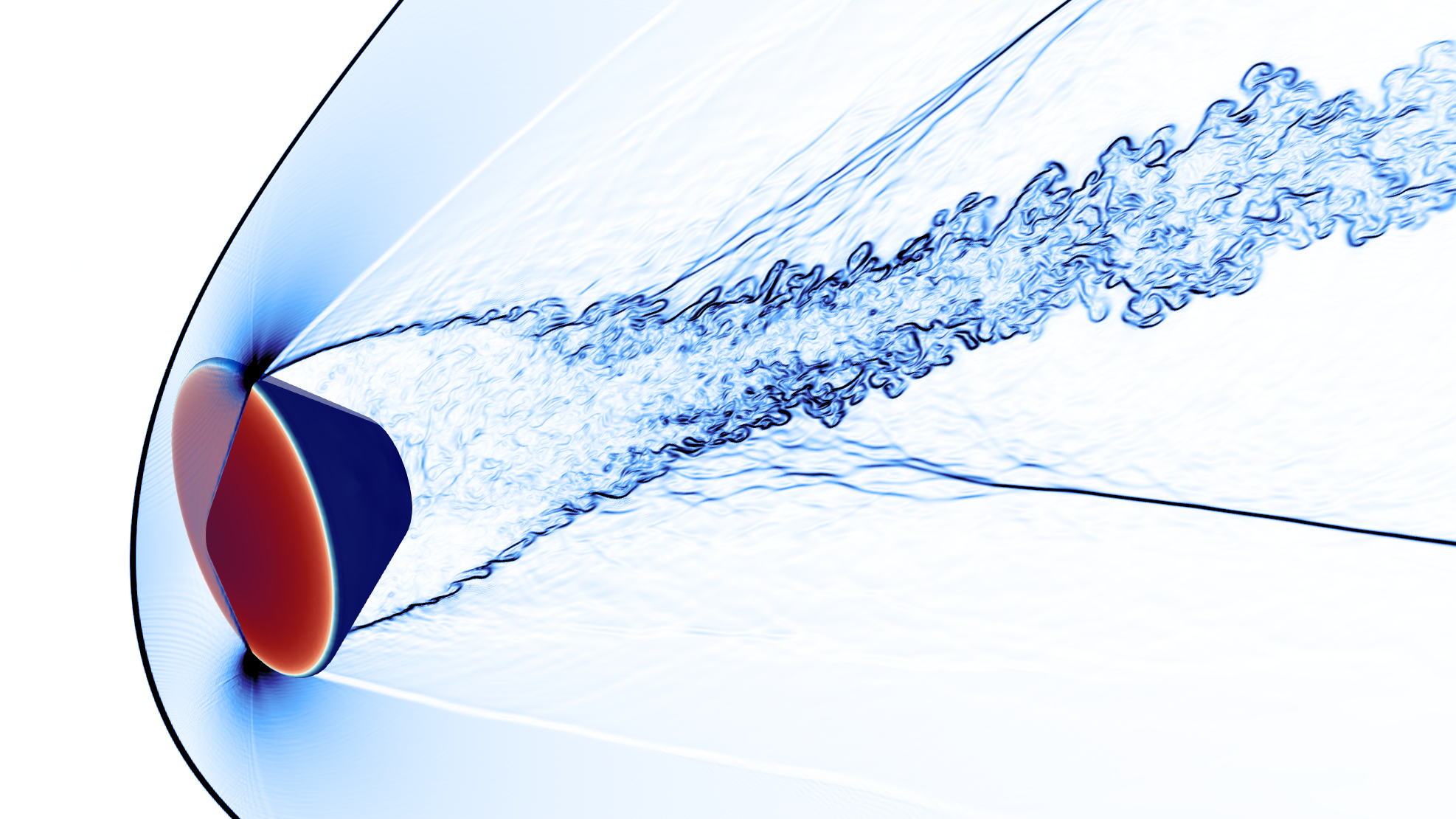 Entry and descent phases of an interplanetary probe are characterized by complex aerodynamic phenomena as the capsule gradually encounters the planet’s atmosphere. We are conducting time-evolving high-fidelity simulations of an entry capsule in a supersonic flight regime (Ma = 2), evaluating its behaviour at different configurations of angles of attack. Turbulent structures effectively solved via ILES technique, allow us to evaluate the flow properties and the capsule’s response both in space and time, placing special attention to the analysis of the turbulent structures responsible for the oscillatory and unsteady dynamics.
Entry and descent phases of an interplanetary probe are characterized by complex aerodynamic phenomena as the capsule gradually encounters the planet’s atmosphere. We are conducting time-evolving high-fidelity simulations of an entry capsule in a supersonic flight regime (Ma = 2), evaluating its behaviour at different configurations of angles of attack. Turbulent structures effectively solved via ILES technique, allow us to evaluate the flow properties and the capsule’s response both in space and time, placing special attention to the analysis of the turbulent structures responsible for the oscillatory and unsteady dynamics.
Reference(s):
- L. Placco, M. Cogo, M. Bernardini, A. Aboudan, F. Ferri, and F. Picano, “Large-Eddy Simulation of the unsteady supersonic flow around a Mars entry capsule at different angles of attack,” Aerospace Science and Technology, vol. 143, p. 108709, 2023.
High fidelity simulation of capsule-parachute interaction during planetary descent
Collaborators: Luca Placco, Michele Cogo, Prof. Francesco Picano, Alessio Aboudan (CISAS), Francesca Ferri (CISAS) and Prof. Matteo Bernardini (Sapienza).
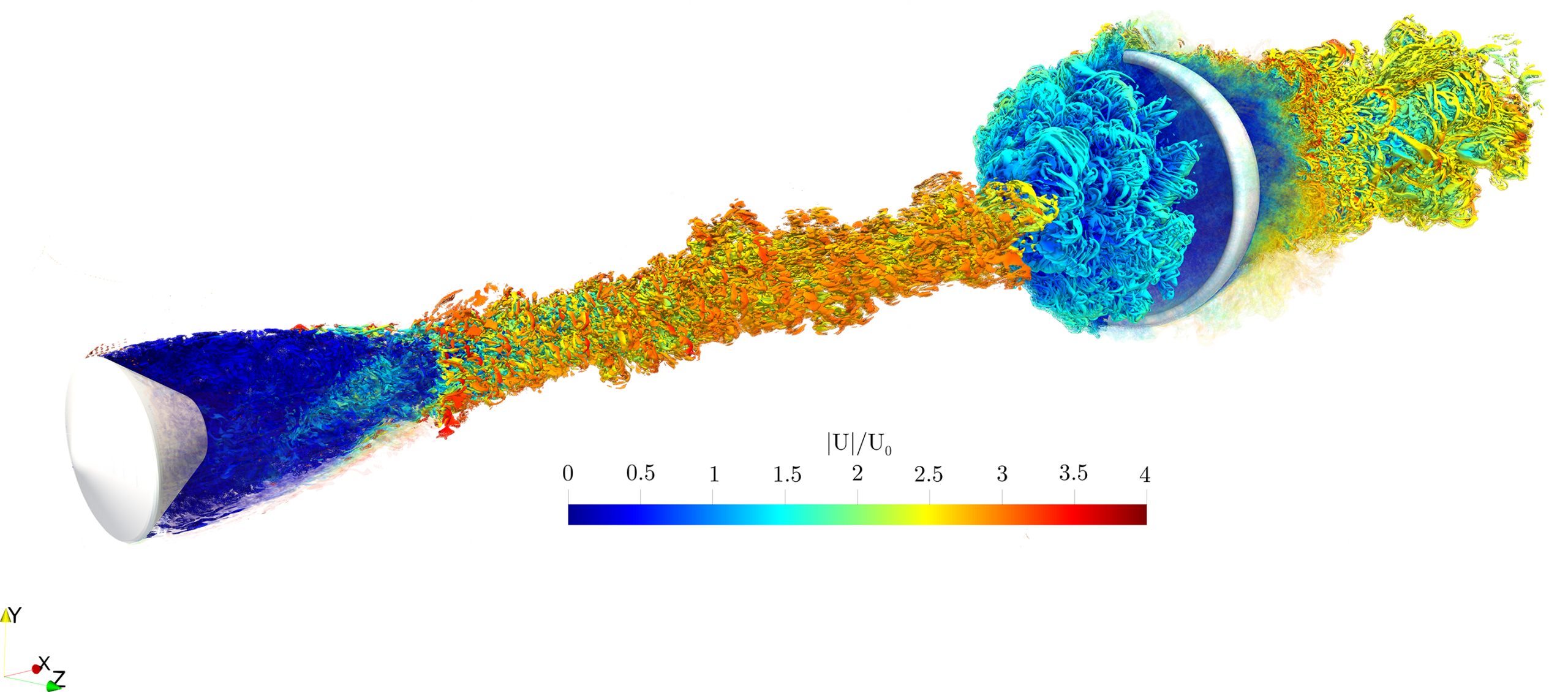 The study aims to establish the fluid dynamic nature of the ‘breathing’ instability present also in rigid structures. The turbulent wake of the descent capsule interacts with the bow shock generated by the parachute acting as the primary triggering factor. Energetic turbulent structures, accurately resolved by Large-Eddy Simulation, induce local fluctuations in the parachute shock, destabilizing its equilibrium with the upstream flow and leading to continuous cyclic motion of the shockwave.
The study aims to establish the fluid dynamic nature of the ‘breathing’ instability present also in rigid structures. The turbulent wake of the descent capsule interacts with the bow shock generated by the parachute acting as the primary triggering factor. Energetic turbulent structures, accurately resolved by Large-Eddy Simulation, induce local fluctuations in the parachute shock, destabilizing its equilibrium with the upstream flow and leading to continuous cyclic motion of the shockwave.
Reference(s):
- L. Placco, G. Soldati, M. Bernardini, and F. Picano, “On flight instabilities of capsule-rigid parachute system during supersonic planetary descent”, Aerospace Science and Technology, Under revision.
Direct numerical simulation of hypersonic boundary layers at high Reynolds numbers
Collaborators: Michele Cogo, Francesco Salvadore (CINECA), Prof. Francesco Picano and Prof. Matteo Bernardini (Sapienza).
 To design the new generation of high-speed aircraft and re-entry vehicles, it is essential to predict the drag and heat flux generated at the boundary of the vehicle, where boundary layers are present. However, the classical theories, from which lots of engineering models are developed, are not able to handle high thermal fluxes at the solid boundaries and intense pressure waves, which increase considerably at high-Mach numbers. We are conducting numerical studies using Direct Numerical Simulation at different Mach and Reynolds number to gauge the effect that these parameters have on the instantaneous and statistical properties of the flow.
To design the new generation of high-speed aircraft and re-entry vehicles, it is essential to predict the drag and heat flux generated at the boundary of the vehicle, where boundary layers are present. However, the classical theories, from which lots of engineering models are developed, are not able to handle high thermal fluxes at the solid boundaries and intense pressure waves, which increase considerably at high-Mach numbers. We are conducting numerical studies using Direct Numerical Simulation at different Mach and Reynolds number to gauge the effect that these parameters have on the instantaneous and statistical properties of the flow.
Reference(s):
- Cogo, M., Baù, U., Chinappi, M., Bernardini, M., & Picano, F. (2023). Assessment of heat transfer and Mach number effects on high-speed turbulent boundary layers. Journal of Fluid Mechanics, 974, A10. https://doi.org/10.1017/jfm.2023.791
- Cogo, M., Salvadore, F., Picano, F., & Bernardini, M. (2022). Direct numerical simulation of supersonic and hypersonic turbulent boundary layers at moderate-high Reynolds numbers and isothermal wall condition. Journal of Fluid Mechanics, 945, A30. https://doi.org/10.1017/jfm.2022.574
DNS of supersonic turbulent boundary layers over rough surfaces
Collaborators: Michele Cogo, Davide Modesti (GSSI), Prof. Francesco Picano and Prof. Matteo Bernardini (Sapienza).
 Surface roughness effects can significantly alter the mechanical and thermal loads applied on high-speed vehicles. Different superficial treatments can lead to the formation of smooth and rough regions, to which the incoming flow is forced to adjust. In this research thread, we perform direct numerical simulations of smooth and rough zero-pressure-gradient adiabatic turbulent boundary layers at different Mach numbers, enabling a direct comparison between supersonic and subsonic regimes. Initial studies consider a rough wall composed of 3D cubical elements, a structured and well-characterized arrangement. The interaction between compressibility and surface roughness, clearly visible with a pattern of compression and expansion waves, is analyzed considering its implication in turbulence and thermal statistics of the flow. Future studies include different geometrical patterns, including realistic roughness, with the ultimate goal to enhance wall modeling algorithms for LES and RANS.
Surface roughness effects can significantly alter the mechanical and thermal loads applied on high-speed vehicles. Different superficial treatments can lead to the formation of smooth and rough regions, to which the incoming flow is forced to adjust. In this research thread, we perform direct numerical simulations of smooth and rough zero-pressure-gradient adiabatic turbulent boundary layers at different Mach numbers, enabling a direct comparison between supersonic and subsonic regimes. Initial studies consider a rough wall composed of 3D cubical elements, a structured and well-characterized arrangement. The interaction between compressibility and surface roughness, clearly visible with a pattern of compression and expansion waves, is analyzed considering its implication in turbulence and thermal statistics of the flow. Future studies include different geometrical patterns, including realistic roughness, with the ultimate goal to enhance wall modeling algorithms for LES and RANS.
Reference(s):
- Cogo, M., Modesti, D., Bernardini, M., & Picano, F. (2024). Direct numerical simulation of compressible turbulent boundary layers over smooth and rough surfaces. Journal of Fluid Mechanics, Under revision.
Turbulent dispersed multiphase flows
Collaborators: Xiang’en Kong, Prof. Francesco Picano and Federico Dalla Barba
 Particle-laden channel flows are prevalent in both industrial processes and natural phenomena, rendering their study highly significant. This research introduces a stochastic modeling approach to enhance near-wall particle transport representation. Using the CaNS software, which integrates WM-LES, particle transport, and stochastic modeling, the methodology was tested in channel flow simulations at a friction Reynolds number of 500 and 1000. Simulation results closely align with DNS data, demonstrating that the proposed wall model effectively captures particle dynamics near the wall.
Particle-laden channel flows are prevalent in both industrial processes and natural phenomena, rendering their study highly significant. This research introduces a stochastic modeling approach to enhance near-wall particle transport representation. Using the CaNS software, which integrates WM-LES, particle transport, and stochastic modeling, the methodology was tested in channel flow simulations at a friction Reynolds number of 500 and 1000. Simulation results closely align with DNS data, demonstrating that the proposed wall model effectively captures particle dynamics near the wall.
Turbulence wall model based on machine learning for high speed flow
Collaborators: Roberto Dal Monte, Prof. Francesco Picano and Michele Cogo
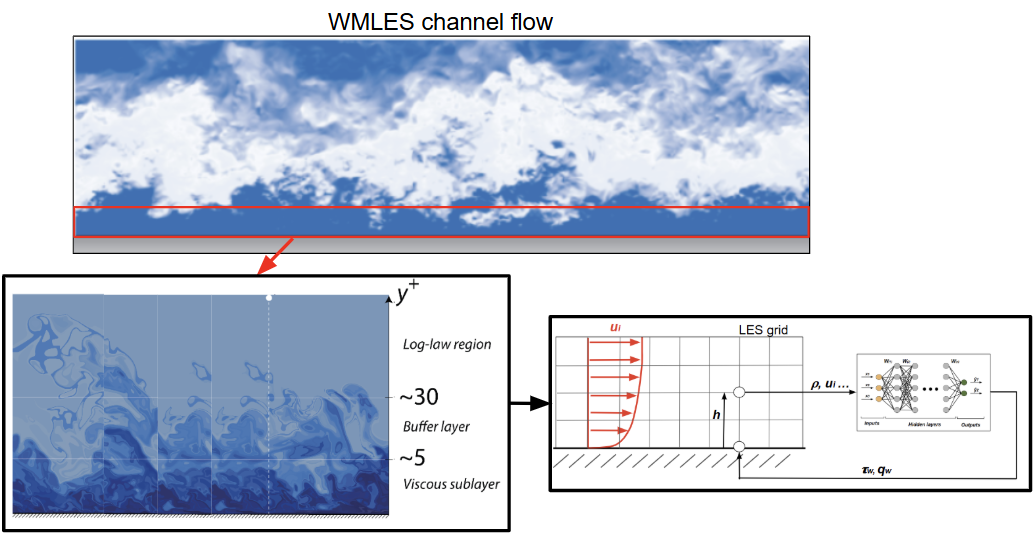 Current turbulence closure models in Computational Fluid Dynamics (CFD) struggle with accuracy, generalizability, and computational cost, particularly in complex regimes like hypersonic flows. Machine Learning (ML) and Deep Learning (DL) could represent promising solutions to reduce the grade of these limitations by introducing data-driven approaches in order to enhance model performance.
My research focuses on integrating ML into wall models used in Large Eddy Simulations (LES) for compressible fluids in the hypersonic regime. The ideal goal is to develop models that are more accurate, scalable, and faster to converge, addressing critical limitations suffered by current methods.
Current turbulence closure models in Computational Fluid Dynamics (CFD) struggle with accuracy, generalizability, and computational cost, particularly in complex regimes like hypersonic flows. Machine Learning (ML) and Deep Learning (DL) could represent promising solutions to reduce the grade of these limitations by introducing data-driven approaches in order to enhance model performance.
My research focuses on integrating ML into wall models used in Large Eddy Simulations (LES) for compressible fluids in the hypersonic regime. The ideal goal is to develop models that are more accurate, scalable, and faster to converge, addressing critical limitations suffered by current methods.
